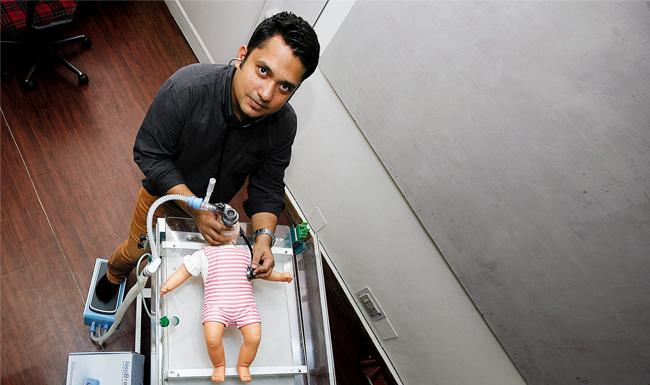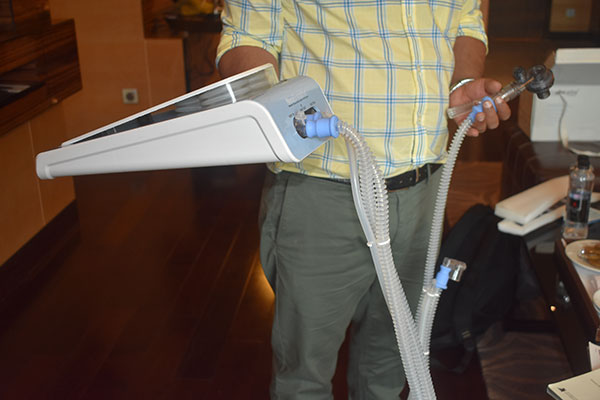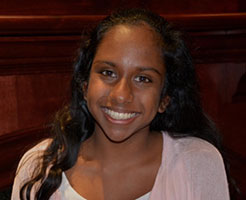Stories
Global Innovator Spotlight: Avijit Bansal
 Dr. Avijit Bansal shared his story with high school student Sophia Nesamoney in the summer of 2017 (Image credit: Vishal Koul for Outlook Business Magazine, India, September 2016).
Dr. Avijit Bansal shared his story with high school student Sophia Nesamoney in the summer of 2017 (Image credit: Vishal Koul for Outlook Business Magazine, India, September 2016).
Avijit Bansal’s love for innovation began with the first book he ever read. He loved stories about engineers, doctors, and inventors who changed the course of human history through innovation. He remembers reading about the Wright brothers and being transfixed by the idea of challenging what was “possible.” As he grew older, his fascination with innovation grew stronger and he continued to ask himself when he would get the chance to create something meaningful for the world.
However, as his fearless self looked towards the day when he could call himself the next Orville or Wilbur Wright, his parents’ plan for him was much more practical. His parents are both doctors, and they wanted him to become one as well. “They gave me sane advice, noting that a degree in medicine would be life-long insurance against financial woes, and would also give me the freedom to experiment, ‘... in case the innovation plane had trouble taking off,’ as it had for the Wright Brothers,” recalled Avijit. They also pointed out that becoming a doctor would give him deep expertise in healthcare; the most human-centered of all areas in need of innovation.
Accepting this advice, Avijit put his dream of being an inventor on hold and decided to concentrate on getting admitted into one of India’s top medical colleges. He was pleased to be accepted into a top-tier medical school. But when his training began, he was restless and struggled to concentrate in his classes. It wasn’t until a peer confronted him that he had a change of heart. “You’re always complaining,” his friend remarked. “If you spent half as much time applying yourself to your school work you’d be a pretty good doctor by now.” Avijit was motivated by the comment to apply himself more fully to his training. As he pushed himself to participate and engage in his classes, he remembered, “Things changed and I started liking what I did.” But it was during his residency [after medical school], that he became truly engaged. “I began to experience the real excitement of medicine—working to alleviate suffering while navigating a myriad of challenges,” he said.
One day while visiting his mother at her clinic, Avijit saw a twelve-year-old boy collapse in her consulting room. His mother checked his breathing but discovered that there was no air coming in or out of his dying body. She sprang into action, delivering artificial breaths with a bag-mask device and giving vigorous cardiac compression. She pushed and pumped until her hands became sore and her arms cramped, yet she never gave up until she saw the color rush back into the boy’s face.
“I was in awe that you can actually bring back people from the dead,” Avijit recalled. The episode seemed to last hours but actually transpired in just 20 intense minutes. However, it left his mom’s hands aching with the familiar pain of performing resuscitation. “The experience and its aftermath both had a lasting impact on me,” he said.
Later, as part of his own residency, Avijit gained personal experience performing regular patient resuscitations. “Yet, despite regular practice and ample training, each event created chaos, confusion, and anxiety,” Avijit described. “The problem was that the dominant hand of the person doing the resuscitation was occupied by the task of compressing the ventilation bag. This left only one hand to perform the triple maneuver of jaw-thrust, chin lift, and neck tilt, in addition to using the fingers of that same hand to create the all-important face mask seal.” He continued, “When I thought about what it must be like to be a in a remote location struggling single-handedly to save a life, I knew there had to be a better way.” Avijit recalled thinking at the time that if doctors could compress the bag by foot, then they would have another free hand to work more precisely and effectively.
After completing his pulmonology residency, Avijit had the opportunity to resurrect his own dream of becoming an inventor. He attended a talk by Dr. MK Bhan, a visionary Indian Biotech leader who had helped conceive the Stanford-India Biodesign program. The goal of this new educational program was to bring together Indian doctors, engineers, designers and business experts to identify important unmet healthcare needs in India and invent technologies to address them specifically for Indian patients. “For that team,” he said, “we are looking for doctors with an engineering bent.” Avijit knew immediately that this was what he wanted to do next.
With just his Biodesign textbook in hand and a determination to succeed, Avijit arrived in California where the first six months of the Stanford-India Biodesign training would take place. As his plane touched down, he remembered Dr. Raj Doshi’s words: “My expectation of what you will take away from this program is just one thing: a reshaping of what you think is possible.”
At Stanford, Avijit was joined by Chinmay Deodhar, a design engineer, Mridusmita Choudhury, a biomedical engineer, and Ayesha Chaudhary, also a biomedical engineer. Together, they learned Stanford’s unique “Biodesign innovation process” and then practiced it on a local project that started with observing the delivery of care at the Lucile Packard Children’s Hospital in order to identify problems areas, researching and screening those “needs,” and then inventing technologies to address the most promising ones.
After learning the approach at Stanford, the team returned to AIIMS, New Delhi to repeat the process in India with the hope of addressing an important unmet global healthcare need relevant for Indian patients. Ultimately, Avijit and his team decided to tackle resuscitation, focusing specifically on a way to make it easier for frontline healthcare workers to resuscitate newborns. “We wanted to address all the challenges of resuscitation in order to save the 800,000 newborns who fail to breathe every year,” Avijit described. He explained that the prevalent thinking was that better resuscitation was a function of better training in this skill-intensive procedure. “We came at it from a different perspective—we wanted to build a solution that made resuscitation easier, so more people could do it single-handedly and effectively.”
 Dr. Bansal shows off the features of the NeoBreathe foot-operated resuscitator.
Dr. Bansal shows off the features of the NeoBreathe foot-operated resuscitator.
After many years of hard work, Avijit and his team introduced the world’s first foot-operated resuscitator for newborns—called Neobreathe. The innovative device not only allows the operator to use both hands to hold and secure the mask, which reduces air leakage by half, but has built-in suction to remove any mucus blocking the airway. It also monitors air pressure and can control oxygen levels without requiring a battery or electric power. “It is the first device that allows a single person to perform full CPR,” Avijit described. NeoBreathe was commercially launched in 2016 at the 10th Annual Indian Medtech Summit, an event that was initiated as part of the Stanford-India Biodesign program. Neobreathe is currently in use in 15 Indian states and one country in Africa. In 2017, the technology was honored with the BIRAC National Award for the commercialization of indigenous technology from the President of India.
According to Avijit, had he not seen his mother save that child, and then felt the aches in his own hands while working to save a life, he would never have had the inspiration to improve resuscitation for doctors and patients worldwide. He also views his participation in the Stanford-India Biodesign as “transformative” in reshaping his career. And he feels indebted to the Biodesign faculty for their ongoing support that extended well beyond the duration of the formal training program. “These are relationships that last for life, and the kind of support that can make all the difference to an aspiring innovator,” he said.
About his decision to pursue a career in medical technology instead of practicing medicine, Avijit explained, “As a doctor I was doing one thing, treating patients. As an innovator, I get to do many different things, meet many different people, and travel to many places. It is humbling to be in a position where one needs the help of so many other people to succeed. And it is incredibly uplifting to get all that help and more.”
Although Avijit has completed his formal education, his love of learning has stuck with him to this day. He hopes to leverage his future success to inspire the future generation of Indian innovators. He remembers the pressure he faced as a high-schooler and hopes to one day create a more innovative mindset in schools across the world. In fact, one of his biggest goals for the future is to open a school in India where he will teach students that, just like his favorite childhood books taught him, life is not about taking the safe or well-beaten path. It’s about finding what moves you and running with that spark until you make a difference in the world.

Sophia Nesamoney is a published author and a student at Castilleja High School in Palo Alto, California. She traveled to India in summer 2017 to interview Avijit Bansal and develop this story. She is also passionate about global health and plans to pursue a career in medicine and writing.
